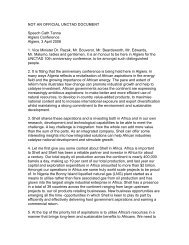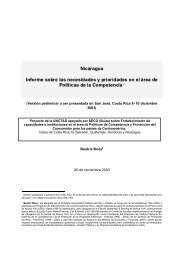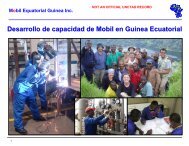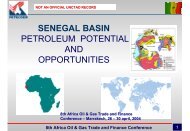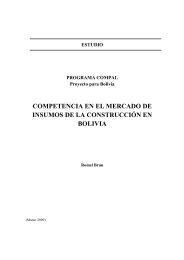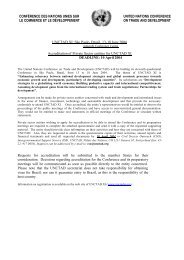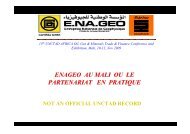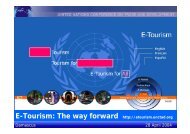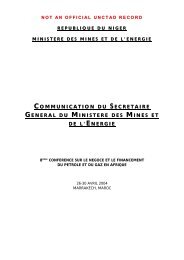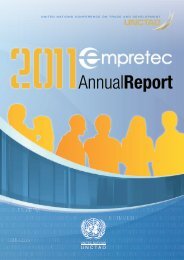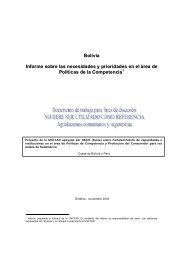Empretec Women in Business Award 2012 publication - Unctad XI
Empretec Women in Business Award 2012 publication - Unctad XI
Empretec Women in Business Award 2012 publication - Unctad XI
- No tags were found...
Create successful ePaper yourself
Turn your PDF publications into a flip-book with our unique Google optimized e-Paper software.
THOUGHTS FROM EXPERTS40Surveys show that women entrepreneurs are not only less likely to have taken out loans but the terms of borrow<strong>in</strong>g tend to be less favorable.They cope with higher <strong>in</strong>terest rates, with demands for more collateral, and with shorter-term loans. 8Some survey results <strong>in</strong>dicate that limitations <strong>in</strong> access to f<strong>in</strong>ance for women entrepreneurs primarily may be associated with their propensity tooperate smaller and <strong>in</strong>formal bus<strong>in</strong>esses. 9 On the other hand, it may be the other way around. It would be a shame to discount the possibility.Beyond the structural, gender-specific constra<strong>in</strong>ts that disadvantage women entrepreneurs – such as legal restrictions on their ability to entercontracts or open bank accounts <strong>in</strong> their own names – firm size has an important <strong>in</strong>fluence on both firm performance and on credit worth<strong>in</strong>ess.The types of bus<strong>in</strong>esses women currently are more likely to run offer lower returns to creditors. <strong>Women</strong> also can bear disproportionate burdens <strong>in</strong>a weak <strong>in</strong>vestment climate that underm<strong>in</strong>es their expected returns – such as dur<strong>in</strong>g the current global economic malaise.Access to “human capital” and collateral are often cited to expla<strong>in</strong> why women are less likely to receive loans. 10 There is no doubt that humancapital is a key asset for entrepreneurs. It <strong>in</strong>cludes not only formal education but also specific bus<strong>in</strong>ess skills such as management techniques.And it relates to the commercial experience and networks of contacts entrepreneurs br<strong>in</strong>g to their bus<strong>in</strong>esses. <strong>Women</strong> entrepreneurs tend to beless educated. This seems seriously to limit their growth potential. 11But they can be educated. The fact that they do so well with less formal tra<strong>in</strong><strong>in</strong>g h<strong>in</strong>ts at their potential. Who wouldn’t want to improve the situation?What could be a better <strong>in</strong>vestment? To address women’s SME growth and their ability to obta<strong>in</strong> f<strong>in</strong>ance, both public and private sector f<strong>in</strong>ance<strong>in</strong>stitutions have roles to play. And <strong>in</strong> some cases these constra<strong>in</strong>ts are be<strong>in</strong>g addressed <strong>in</strong> <strong>in</strong>novative ways. For example, a number of commercialbanks <strong>in</strong> develop<strong>in</strong>g countries have realized the potential economic good more well-tra<strong>in</strong>ed and well-f<strong>in</strong>anced women entrepreneurs can provide.They are look<strong>in</strong>g carefully at specific cases and f<strong>in</strong>d<strong>in</strong>g ways to provide greater credit and “alternative” forms of collateral. And they’re help<strong>in</strong>g toprovide tra<strong>in</strong><strong>in</strong>g <strong>in</strong> bus<strong>in</strong>ess and f<strong>in</strong>ancial management to capitalize on female talent and ambition. That should pay off for everyone, and should<strong>in</strong>crease the proportion of larger SMEs owned by women.Strengthen<strong>in</strong>g women’s participation <strong>in</strong> the private sector will not only further empower women but – most importantly – harnesses an untappedpotential for rais<strong>in</strong>g liv<strong>in</strong>g standards <strong>in</strong> poor regions of the world.Peer Ste<strong>in</strong> is Senior Investment Officer at the International F<strong>in</strong>ance Corporation, Wash<strong>in</strong>gton D.C., United States. He has also led the IFC’s e-f<strong>in</strong>ance<strong>in</strong>itiative for f<strong>in</strong>ancial <strong>in</strong>termediaries. Marieme Esther Dassanou is Global Specialist <strong>Women</strong>’s Access to F<strong>in</strong>ance at World Bank Group, Wash<strong>in</strong>gtonD.C., United States. In their role, they work with f<strong>in</strong>ancial <strong>in</strong>stitutions and state-of-the-art technology providers to adapt f<strong>in</strong>ancial, <strong>in</strong>formation &communication technologies to the bus<strong>in</strong>ess needs of banks and non-banks <strong>in</strong> emerg<strong>in</strong>g markets and transition countries.8. Bardasi et al. (2007); Demirguc-Kunt et al. (2008); Diagne (2000); Ellis et al. (2007); GEM, IFC (2005); Faisel (2004); Rose (1992); ILO/AfDB (2004); Goheer (2003); Nara<strong>in</strong> (2007); Richardson et al. (2004).9. Hundley (2001).10. World Bank Agriculture Resource Book, 2008, ibid, de Janvry and other (2006); World Bank (2004).11. Hallward Dreimeier et al. (2011).



